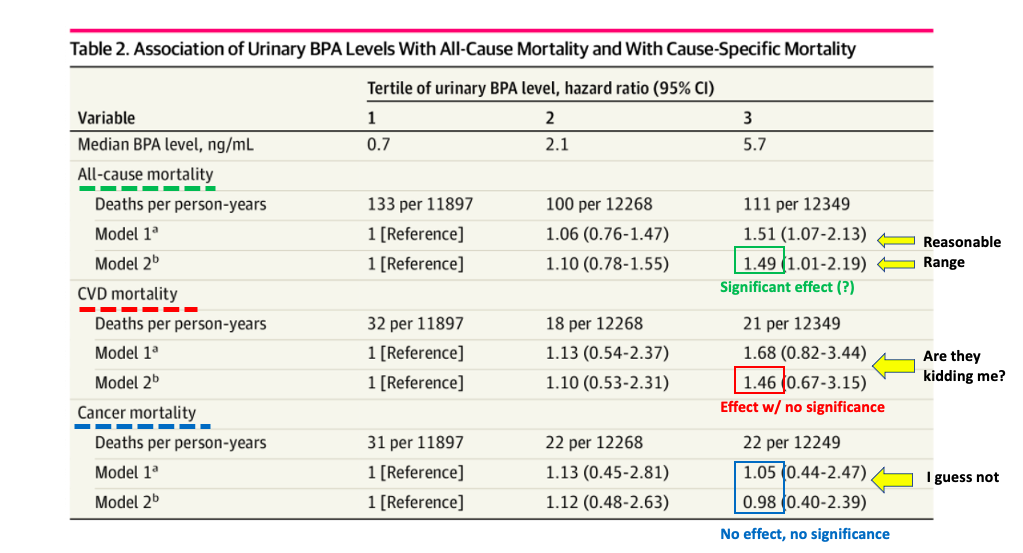According to our new (aka working) search box I have written about bisphenol A (BPA), one of the chemicals used to make polycarbonate plastics (1), 113 times. According to my scientific calculator, this is about 112 times too many. But, your buddies at ACSH have taken on the unenviable task of separating junk from real science, and there is SO much junk in the literature about BPA, including one relatively new JAMA paper, that I must regretfully take a shot at #114. Fortunately, it won't take long.

The chemical reaction used to synthesize BPA polycarbonate plastic.
BPA has been in use for 60 years, primarily to make the plastic that properly seals food cans, keeping out oxygen, which can result in the formation of pathogenic bacteria. One of these is Clostridium botulinum, which is responsible for botulism. Perhaps this is where the expression "kick the can" came from. For approximately 70 of those 60 years, a huge group of scientists and faux environmental groups have been working non-stop to find something wrong with it. That this has proven to be a fruitless exercise hasn't stopped the hardcore "anti-beepers" from trying to find something harmful with it, despite an exhaustive two-year study in rats conducted by the FDA. The agency concluded:
"FDA’s current perspective, based on its most recent safety assessment, is that BPA is safe at the current levels occurring in foods. Based on FDA’s ongoing safety review of scientific evidence, the available information continues to support the safety of BPA for the currently approved uses in food containers and packaging."
FDA: Bisphenol A (BPA): Use in Food Contact Application, June 2018
The "trouble," according to anti-beepers, is that some of the BPA polycarbonate plastic breaks down (reverse of reaction above) to give free BPA, which then leaches into the can. This is true. Also, BPA is used for other purposes, such as cash register receipts and plastic bottles. So, if you measure the urine of everyone on earth, chances are that there will be at least some detectable BPA in their urine. But, it is well known that the presence of a chemical does not equate to any harm from it, and the fact that BPA is found in urine is a sign that our livers are performing their function of metabolizing and clearing xenochemicals from the blood.
The JAMA paper in question can be thrown into the trash; this is easily seen by simply looking at the author's data table (such as it is).

The Problems
1) The authors explain in great detail information on variables – "age, sex, race/ethnicity, educational level, family income, smoking status, alcohol drinking, physical activity, and dietary intake..."
While this information is normally important in ensuring that the best comparative datasets are used – especially important for removing biases associated with retrospective studies (data dredging) that might account for confounding factors, none of it matters here (see below).
2) "...was collected using questionnaires..."
Self-reporting information in surveys, especially those lasting for five years (2003-2008), is a notoriously inaccurate way to collect data. It relies on the memory, honesty, and accuracy of the participants.
3) The measurement of BPA is in urine, which is where it's supposed to be. This tells us little or nothing about the concentration in the blood, where the chemical could conceivably do some damage.
4) None of the above matters. Ignore it. Instead, look at the highlights I have added to the paper's data table. It borders on hilarious.
- All-cause mortality (green hatch line) is reported as 1.49 – a 49% increase (green box) in the highest tertile only. The range of values is within a relatively small range (yellow arrow), suggesting that the data are statistically significant. Even if this is true, this number is the ENTIRE basis of the paper.
- Cardiovascular mortality (red hatch line) is reported as 46% higher (red box) in the highest tertile, but this data is not statistically significant. Not even close. This becomes screamingly obvious when you look at the range of values – 0.67-3.15. One could pretty much throw darts and get such a dataset.
- Cancer mortality (blue hatch line) is unaffected by BPA, regardless of the urine concentration. AND these results are also lacking in statistical significance; note the range 0.4.-2.4. More darts.
Not to belabor the obvious...
But, if the group of people with the highest BPA in their urine is dying 49% more but not from heart disease or cancer then what is killing them? Crabs? Cell towers? The answer is that there is no answer. This is just one more paper where a single number, supposedly legitimate, is the entire basis of the story but it not only is not supported by other data but even seems to contradict it.
Verdict?
My colleague Cameron English sums it up nicely:
"So after all the years and money wasted on these lousy epidemiological studies, no one has figured out how BPA could increase the risk of mortality?"

Sorry, guys. File it here.
NOTE
(1) Most of the rest of BPA is used to make epoxy resins, which are more stable than polycarbonate plastics.




